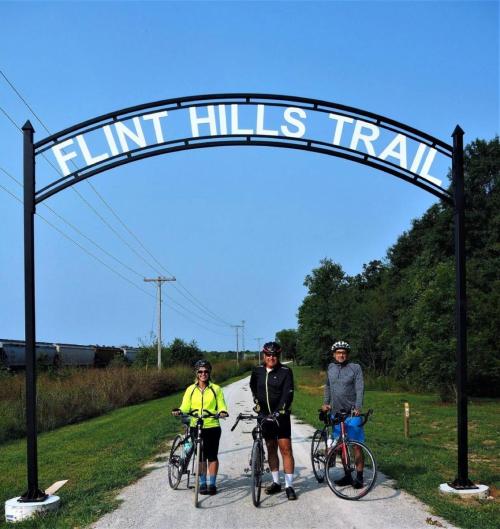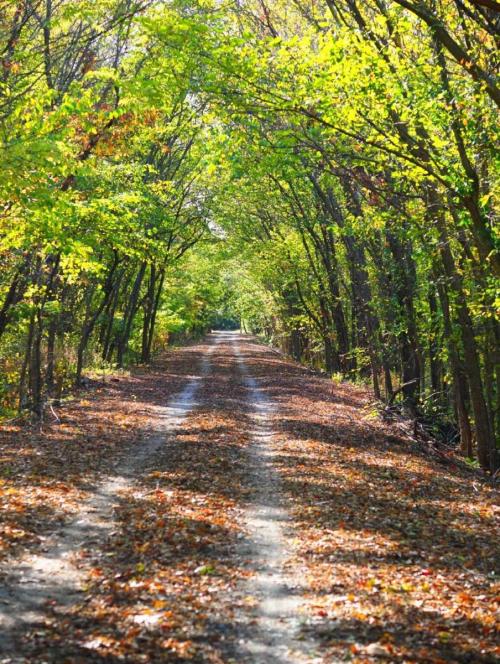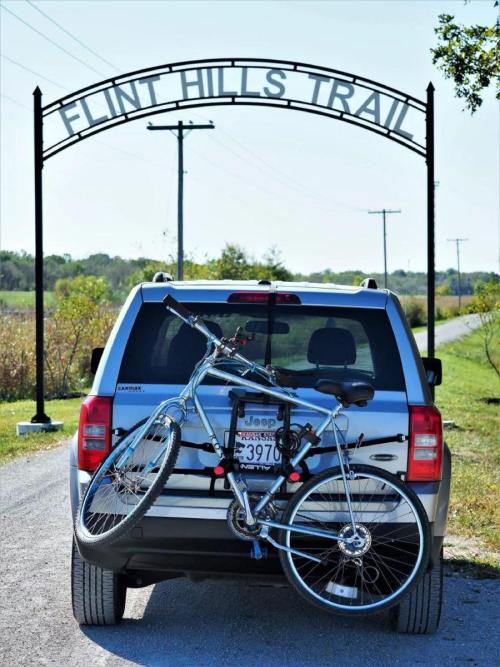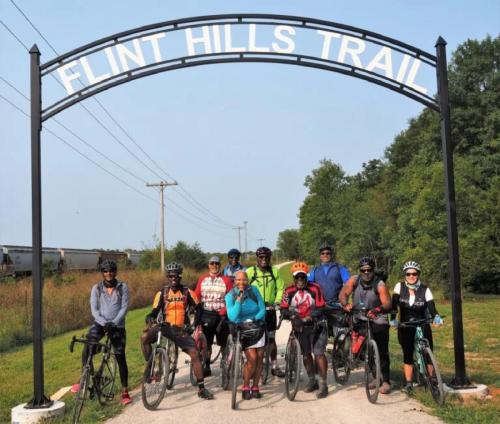Flint Hills Trail Mile Zero Trailhead

The jewel in Osawatomie’s recreational crown is by and large the newly developed Flint Hills Trail eastern terminus trailhead, located at 1400 South Street behind the Karl E. Cole Sports Complex in southwest Osawatomie.
Of the Flint Hills Trail, the Kanza Rail-Trails Conservancy says “As its name suggests, the trail crosses the beautiful Flint Hills. The Flint Hills represent one of the last remaining tallgrass prairie ecosystems in the world. It is home to abundant prairie plant and wildlife species, spectacular views, national historic sites, and a diverse set of recreational areas. The eastern portions of the route travels alongside the Marais Des Cygnes River, between rushing waters and towering bluffs, through rolling farmland and riparian woodlands.
The Flint Hills Trail is the seventh-longest rail-trail in America, and the longest trail in Kansas. It follows the general route of the Santa Fe National Historic Trail and forms a component of the coast-to-coast American Discovery Trail.”
Dubbed “Mile Zero” of the Flint Hills Trail, Osawatomie’s role as the eastern terminus makes it the perfect starting (or stopping) point for trail enthusiasts of all ages and abilities, and is within easy driving distance for the majority of the Kansas City metro area. The trail and trailhead are open year round from dawn to dusk for cycling, hiking, walking, and horseback riding. No motorized vehicles are allowed on the trail except for those used as mobility aides or for approved trail maintenance.
Coming Soon: Amenities at Mile Zero include the newly built Walker Station informational kiosk (modeled after traditional train station architecture and named for Kansas trails pioneer Doug Walker), a solid waste and recycling center, and public restroom facility. The dual parking lots are equipped for a large volume of motor vehicles and the large lot even includes several dedicated stalls for horse trailers. A custom designed pedestrian bridge crosses a ditch 1/4 mile from the trailhead entrance and its design mirrors our two nationally celebrated triple span bridges that bookend the north and south of Osawatomie.

We welcome trail traffic with open arms and open hearts, and love seeing people discovering our community. We have several projects on the books for 2021-2025 that incorporate trails, bicycles, and other great recreation opportunities in and around our community. Wayfinding signage, historical markers, and other great features are all coming soon too.
Read on for a complete history of how the Flint Hills Trail wound its way into the heart of Osawatomie…

Where It Began
Starting in 1995 a group of committed volunteers, led by former Osawatomie School Teacher and Councilmember Doug Walker, formed the Kanza Rails-Trails Conservancy to take over the 117 miles of abandoned Missouri Pacific railbed between Herington and Osawatomie across south-central Kansas. This railbed followed portions of the Sante Fe trail, which was a key gateway in opening up the American West. The hope was that in time the railbed could be transformed into a bicycle and pedestrian trail that would bring travel and tourism into these small communities. It wasn’t until 2003 that the first few miles of the new trail were created. By 2005, a 17-mile section of trail reaching from just outside of Osawatomie heading west toward Ottawa was finished. Today, 96 miles of finished trail stretches from Osawatomie to Council Grove. This has truly been a labor of love across six counties and 15 communities involving thousands of volunteers.
The Intersection of Hope and Dreams
Over the last decade, as the trail inched toward completion, there was a noticeable uptick in the number of people parking just outside of town and jumping on the Flint Hills Trail along John Brown Highway (where the trail had come to a natural end). It became clear that if the City wanted to take advantage of this hidden gem, we needed to “pull the trail” into town. The trail could be key in creating a rebirth of the downtown retail corridor, and it gave the community a bit of hope. People were finding the trail; maybe they would find our downtown if we gave them an easier way to get to it. But the work required by that idea wasn’t going to be easy. This project would unequivocally be the community’s largest single Capital Improvement Project in a decade. We didn’t have the money to do it, and there were private parcels that we would need to purchase in order to make the connection work. We knew where we wanted the trailhead to be, but how were we going to make all of this work? The hill looked almost too steep to climb. We needed to find a group of committed individuals and the support of local foundations, organizations and governments. Where do we start?
It’s at this point that we seized upon the quote of Arthur Ashe: “Start where you are. Do what you can. Use what you have.” Doug Walker, board member and president for the Kanza Rail-Trail Conservancy, got the ball rolling. Working with then City Manager Don Cawby, Doug met with Councilmember Jeff Walmann and their conversation led to the idea of forming a taskforce. On September 25, 2018 the Osawatomie City Council created the Osawatomie Trail Taskforce and there was our start. The Taskforce was going to be responsible for the development, construction and promotion of recreation trails in the Osawatomie area and the first one to be worked on was the increasingly popular Flint Hills Trail.

The Taskforce at its inception had a very broad membership, including a City Councilmember and representatives from the Chamber of Commerce; Osawatomie School District; Miami County; City staff; the Department of Kansas Wildlife, Parks and Tourism; a local banker (First Option Bank); plus, three volunteer community members. The taskforce met monthly and through their hard work were able to raise more than $150,000 from individuals, corporations, foundations and local governments, including the Hawkins Foundation, Sunflower Foundation, and the Baer Foundation. These dollars were used to complete the last half-mile of the existing trail and connect it to a new eastern terminus trailhead built just west of the Karl E. Cole Sports Complex, along with the construction of a parking lot to serve trail users. Those first pieces were completed in 2019. We did what we could.
That last half mile has already made a difference. From the annual Rush the Rail event to being a premier destination for cyclists throughout the region, the Flint Hills Trail’s eastern terminus is quickly becoming the number one tourist stop in Osawatomie and Miami County. Community surveys and our best estimations indicate that in the summer months there are generally between 50 – 75 more people in town during the week (mushrooming to twice that number over the weekend) – all brought here by the trail. We have been able to use what we have, a trailhead, to make what we believe is the beginning of one our largest investments in economic development. And we’re just getting started. That original investment has generated another $350,000 in donations to build trail amenities (waystation, kiosk, solid waste/recycling facilities, and bathroom facilities).
With the success of our work on building our trailhead and its features, we’re going to be sharing our sets of plans with other communities along the trail so that they can invest in their stops without the burden of paying for all the architectural and engineering costs associated with these structures. It’s that foundational work of the Osawatomie Trail Taskforce that’s made all the difference in our community – and hopefully will make a difference in the communities that share the trail with us.
